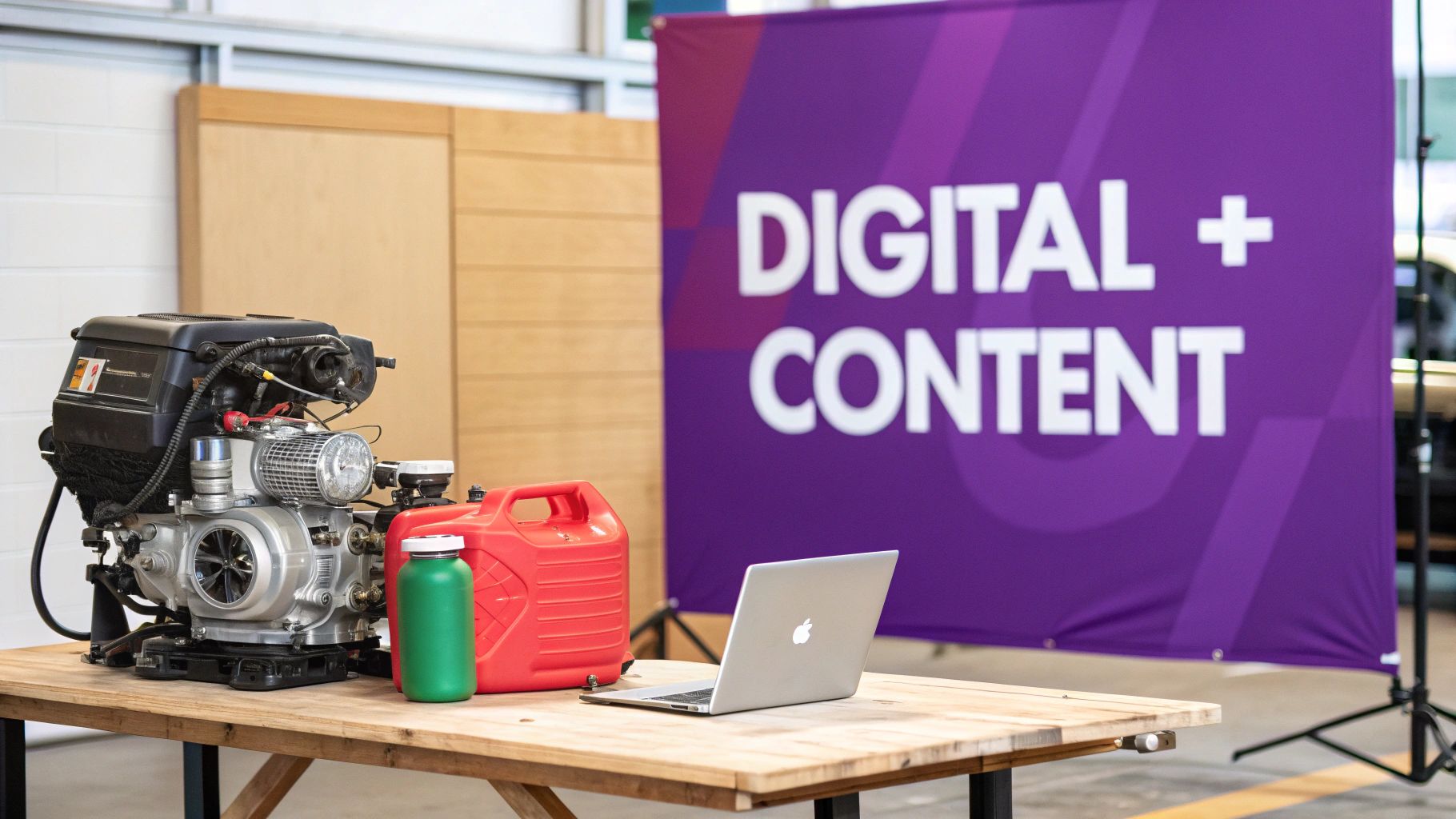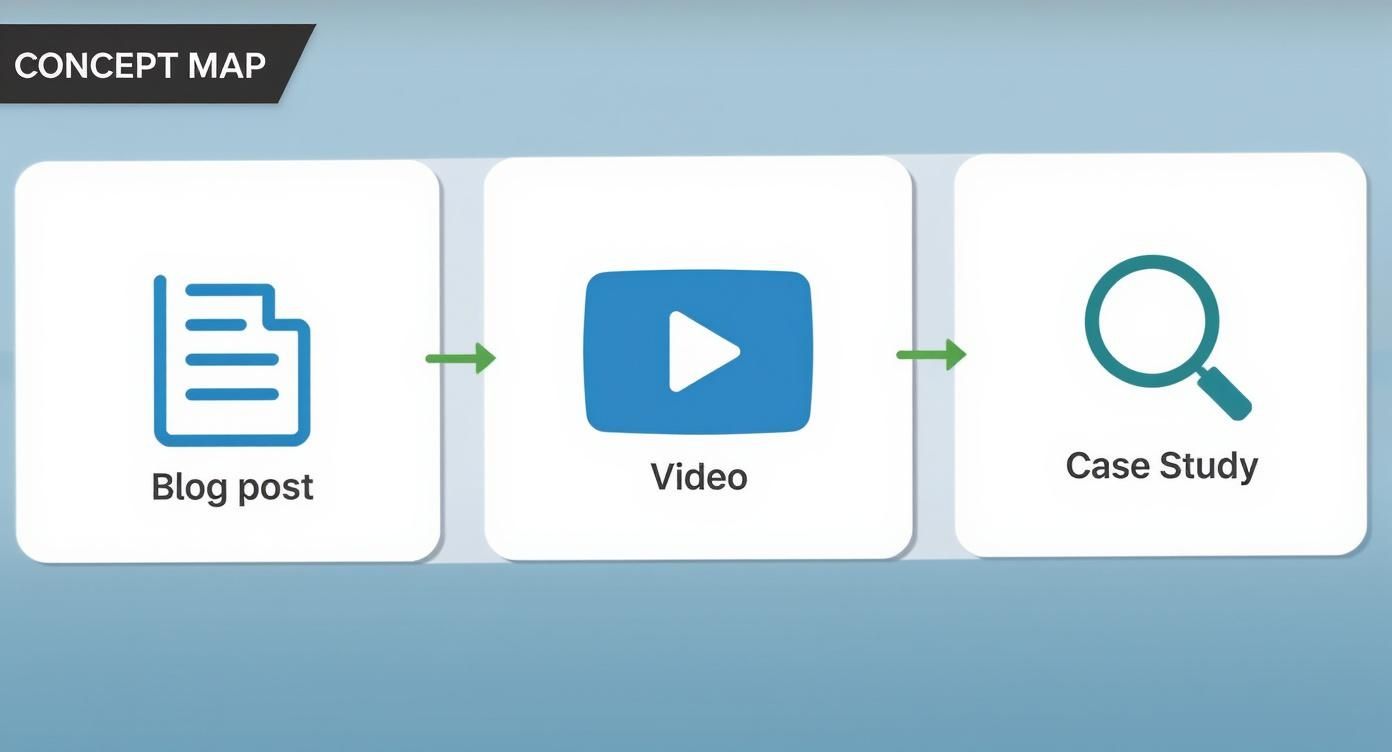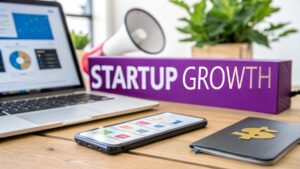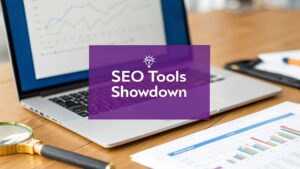Content marketing and digital marketing are two sides of the same coin. Think of it this way: digital marketing is the engine, and content marketing is the premium fuel that makes it run. One simply doesn't work without the other.
How Content and Digital Marketing Drive Business Growth

For UK businesses trying to get ahead online, understanding how these two disciplines work together isn't just a "nice-to-have"—it's absolutely critical. One of the most common mistakes I see is businesses treating them as separate tasks, which seriously caps their potential. When you bring them together, you create a powerful, self-sustaining presence that doesn't just attract customers but keeps them coming back.
Imagine digital marketing is the entire network of roads, vehicles, and signposts leading people to your business. This network includes everything from SEO and social media ads to email campaigns. But without a destination worth visiting, those roads lead absolutely nowhere.
Digital vs Content Marketing At a Glance
To make this crystal clear, let's break down the core differences in a simple table. This should help you see how the "engine" and the "fuel" fit together in practice.
| Aspect | Digital Marketing (The Engine) | Content Marketing (The Fuel) |
|---|---|---|
| Primary Focus | Promoting your business and driving traffic through various online channels. It's about getting the message out there. | Creating valuable, relevant, and helpful information that builds trust and authority. It's about giving people a reason to care. |
| Common Channels | SEO, PPC Ads, Social Media Marketing, Email Marketing, Affiliate Marketing. | Blog Posts, Videos, E-books, Case Studies, White Papers, Podcasts, Webinars. |
As you can see, digital marketing gives you the means to reach people, while content marketing gives you the substance to engage them once you do.
The Inseparable Duo
Content marketing creates that worthwhile destination. It's the craft of producing genuinely helpful material—like blog posts, videos, and guides—that your audience actually wants to consume. This is the substance that gives your digital marketing a real purpose.
Let's put it in practical terms:
- An email campaign (digital marketing) is just spam without a compelling message and offer (content).
- Your social media profiles (digital marketing) are empty shells without engaging posts and visuals (content).
- SEO (digital marketing) can't get you ranked without high-quality articles and web pages (content) for search engines to index.
On the flip side, even the most brilliant piece of content will just gather digital dust if it isn't pushed out through the right channels. This symbiotic relationship is the absolute foundation of modern online success.
A huge misstep is pouring money into digital advertising before building a solid library of quality content. It’s like buying an expensive TV ad slot but having nothing to show. Real growth comes when the two are seamlessly integrated.
Building a Strong Foundation
If you're just starting out or want to brush up on the fundamentals, checking out this beginner's guide to digital marketing can give you a solid footing.
This guide will dive deeper into how to unite these two powerful disciplines, ensuring your digital engine has the high-grade fuel it needs to leave competitors in the dust. By the end, you'll see why successful online promotion is never about choosing one over the other, but about mastering how they work in perfect harmony.
Understanding Your Digital Marketing Engine
Digital marketing is the big picture—it's the entire framework for everything you do to promote your business online. Think of it as the complete engine that powers your business's growth. It’s not just one thing; it's a collection of interconnected parts, all working together to find your customers wherever they are online and get your message in front of them.
This engine isn't a single component but a set of powerful tools. Each has a specific job, but they all share the same goal: connecting your business with potential customers and guiding them towards making a purchase. Getting to grips with these core components is the first step to building a really solid online presence.
The Essential Tools in Your Kit
Imagine digital marketing as a toolkit filled with specialised instruments. While there are countless options out there, four are absolutely essential for any modern business: Search Engine Optimisation (SEO), Pay-Per-Click (PPC) advertising, social media marketing, and email marketing. If you can get these right, you’ll have a strong foundation for growth.
Let's break down what each of these tools actually does.
Search Engine Optimisation (SEO)
SEO is all about getting your website to show up higher in search engine results, like on Google, without paying for ads. When someone in Cambridge searches for "local accountancy firms," SEO is what helps your website appear on that crucial first page. It's a long-term game focused on earning organic (unpaid) traffic.
So how does it work? It boils down to a few key areas:
- On-page SEO: Making sure your website's content, keywords, and overall structure are crystal clear to search engines.
- Off-page SEO: Building your website's credibility and authority by getting links from other reputable sites.
- Technical SEO: Ensuring your site is fast, secure, and easy for search engines to crawl and understand.
The ultimate goal is to signal to Google that your website is the most relevant, trustworthy answer to what someone is looking for.
Pay-Per-Click (PPC) Advertising
While SEO earns you visibility over time, PPC lets you buy it instantly. With PPC, you can place targeted ads right at the top of search results or on other websites, and you only pay when someone actually clicks on your ad. It’s a fantastic way to drive immediate traffic and quickly test which of your messages are hitting the mark with your audience.
PPC offers speed and precision. You can launch a campaign and start seeing traffic within hours, making it perfect for special promotions, new product launches, or when you just need to get leads in the door fast.
A truly effective online presence combines both paid and organic search tactics. To get a better idea of how they fit together, you can explore various search engine marketing strategies that balance short-term wins with long-term, sustainable growth.
Social Media Marketing
Social media marketing is about using platforms like LinkedIn, Instagram, or Facebook to build your brand, connect with your audience, and drive people back to your website. It’s less about the hard sell and more about creating a community and nurturing relationships.
This channel is no longer optional for UK businesses. The UK’s social media advertising market is projected to hit £9.95 billion in 2025. And with 79% of the UK population actively using social media, it's a space you simply have to be in. If you're interested in the numbers, you can discover more insights about UK social media trends on Sprout Social.
Email Marketing
Email marketing remains one of the most direct and personal ways to talk to your customers. It's all about sending targeted messages—like newsletters, special offers, or helpful tips—to a list of subscribers who have explicitly agreed to hear from you.
Unlike with social media, you own your email list. That direct line of communication is incredibly powerful for nurturing leads and encouraging repeat business, making it one of the most cost-effective tools in your entire digital marketing engine.
Fuelling Your Engine with Great Content Marketing
If digital marketing is the engine that drives your business forward, then content marketing is the high-grade fuel that makes it actually perform. It’s a strategic approach, really, all about creating and sharing genuinely valuable, relevant, and consistent material to pull in and hold onto a specific audience. The end goal is to drive profitable customer action, but it gets there by building a relationship first.
Think of it like a good conversation on a first date. You wouldn’t just launch into talking about marriage and kids right away. You’d build some rapport, share a few interesting stories, and show you're someone worth getting to know. That's exactly what content marketing does for your business; it offers real help instead of just a hard sell.
This whole approach is about shifting from interruption to invitation. Instead of shouting for attention with a disruptive advert, you create useful resources that your ideal customers are already looking for. It's the difference between a cold call and a warm, helpful chat.
The Power of Providing Value First
The core idea behind content marketing is pretty simple: if you consistently give your audience something of value, they will eventually reward you with their business and loyalty. This method builds a foundation of trust and positions your brand as a credible authority in your field. When a potential customer has a problem, you want your business to be the first one that pops into their head.
This is all done through different types of content, with each one playing a unique part in engaging customers wherever they are in their journey.
- Blog Posts: These are perfect for answering specific customer questions, boosting your Search Engine Optimisation (SEO), and showing off your expertise.
- Videos: Highly engaging and easy to share, videos are fantastic for product demos, customer testimonials, and telling your brand’s story with a more personal touch.
- Case Studies: These offer concrete proof that your product or service actually works, helping to nudge potential customers who are close to making a decision.
- Infographics: By taking complex information and making it visually appealing and easy to digest, infographics can make your data more understandable and shareable.
The key takeaway here is that content provides the substance that makes all your digital marketing efforts meaningful. Without it, your emails are empty, your social media is silent, and your website has no real reason for visitors to stick around.
Content as a Core Business Strategy
Content marketing isn't just a "nice-to-have" anymore; it's become a cornerstone of digital strategy for businesses right here in the UK. Recent data shows that 81% of marketers in the UK now consider content marketing a core business strategy in 2025. What's more, companies that actually have a documented content strategy see a 33% higher return on investment compared to those who don't, proving that planning and consistency really do pay off.
This commitment to content is fuelled by its ability to generate sustainable, long-term results. While a paid ad campaign stops delivering traffic the second you stop paying, a single high-quality blog post can attract organic visitors for years. This makes getting to grips with content marketing best practices absolutely crucial for any business serious about building a lasting online presence.
To really get that digital marketing engine roaring, especially in an e-commerce setting, it pays to explore effective content marketing strategies for e-commerce that can directly lift sales and engagement. By creating content that helps, educates, or entertains, you're not just selling a product; you're building a brand that people trust and want to connect with. And that, right there, is the foundation of modern business success.
Unifying Your Strategy for Maximum Impact
Right, this is where it all clicks into place. Think of digital marketing as the engine and content marketing as the high-octane fuel. On their own, they have potential. But when you connect them, you build a powerful vehicle for business growth. When you harmonise these two, you stop seeing them as separate tasks and start creating integrated campaigns where every part makes the other stronger.
This is where the real magic happens. A brilliant blog post that nobody sees is a missed opportunity. Likewise, a slick social media campaign with nothing valuable to say is just noise. The goal is to get them working together seamlessly, creating something far more powerful than the sum of its parts.
From Content Creation to Customer Conversion
Let's walk through a real-world scenario for a UK business. Imagine a financial adviser based in Cambridgeshire wants to attract more local clients who are starting to think about retirement.
Step 1 The Content Asset
Everything kicks off with content marketing. The firm creates a detailed, well-researched blog post: "The Ultimate Guide to Retirement Planning in Cambridgeshire." It tackles common local concerns, answers specific questions about regional property prices, and offers genuinely useful advice.
Step 2 Digital Marketing Amplification
With the valuable content ready, digital marketing steps in to get it in front of the right people.
- Email Marketing: The guide is the star feature in the firm’s monthly newsletter, sent out to their existing contacts and leads.
- Social Media Marketing: Key takeaways from the post are turned into bite-sized snippets for LinkedIn and Facebook, always with a clear link driving people back to the full article.
- Search Engine Optimisation (SEO): The post is carefully optimised with phrases like "retirement advice Cambridge" to make sure it shows up high on Google when potential clients are searching. This brings in a steady stream of organic traffic over time.
Suddenly, that single piece of content has multiple pathways to an audience, each powered by a specific digital marketing tactic.
A B2B Lead Generation Example
Let's try another one, this time for a B2B software company in Manchester that needs to generate high-quality leads.
The heart of their campaign is a compelling video case study (the content). It features a well-known local client explaining the incredible results they’ve achieved with the software. This video isn't just a sales pitch; it's a powerful story that provides social proof and shows real, tangible value.
This high-value content then becomes the centrepiece of a targeted LinkedIn advertising campaign (the digital marketing). The campaign is set up to reach decision-makers in specific industries, all within the Greater Manchester area. The ad sends them to a dedicated landing page where they can watch the full case study after popping in their contact details. Just like that, the sales team has a pipeline of qualified B2B leads to follow up on.
In both of these examples, the content gives the audience the reason to engage, while digital marketing provides the pathway for that engagement to happen. One simply can't hit its full potential without the other.
The infographic below neatly illustrates how different types of content become the foundation for all sorts of digital marketing activities.

This visual map makes it clear: your content marketing and digital marketing aren't separate functions. They're deeply connected parts of one unified process.
Integrated Campaign Synergy Examples
To really get a grip on this, it helps to map out how different assets and channels can work together. A structured approach means every piece of content you create has a clear promotional plan, and every digital channel you use has a steady supply of quality fuel.
The table below breaks down a few examples of this synergy in action.
| Content Marketing Asset | Primary Digital Marketing Channel | Supporting Tactic | Business Goal |
|---|---|---|---|
| In-depth "How-To" Blog Post | Search Engine Optimisation (SEO) | Social Media Sharing | Increase organic website traffic and build authority |
| Customer Testimonial Video | Paid Social Media Ads (e.g., LinkedIn) | Email Newsletter Feature | Generate qualified B2B leads |
| Industry Research Report | Gated Landing Page | Online PR Outreach | Capture high-value email contacts for nurturing |
| Infographic with Key Statistics | Pinterest & Instagram | Blog Post Embed | Drive brand awareness and encourage social shares |
As you can see, the content asset is just the starting point. Its real power is unlocked when amplified by the right digital marketing channels.
By planning your content marketing and digital marketing activities this way, you create powerful, multi-channel campaigns. These campaigns build momentum, engage your audience at every touchpoint, and ultimately, drive sustainable business growth.
A Practical Framework for UK SMEs

Moving from theory to action is always the tricky part. It’s one thing to know that content and digital marketing should work together, but it’s another thing entirely to build a unified strategy from scratch. This is especially true for UK SMEs, where time and money are always in short supply.
To make things easier, here is a practical, five-stage framework. It breaks the whole process down into manageable steps, designed for business owners who are likely wearing many hats and don't have a dedicated marketing team.
Stage 1: Define Your Audience
You simply can't create content that connects or run ads that convert if you don’t know who you're talking to. Before you do anything else, you need to pin down your ideal customer. Don't worry, this doesn't mean commissioning expensive market research—a simple 'customer persona' is a fantastic starting point.
A customer persona is just a semi-fictional sketch of your ideal client, based on the data you already have and a bit of educated guesswork. Give them a name, a job, and think about what keeps them up at night.
- Who are they? Think about their job title, the industry they’re in, and where they’re based in the UK.
- What are their goals? What are they trying to achieve, either in their job or personal life, that you can help with?
- What are their pain points? Get specific about the problems and frustrations you can solve for them.
Answering these questions gives your content marketing and digital marketing efforts a laser-sharp focus. You’re no longer shouting into the void; you’re talking directly to ‘David, the operations manager from Bristol who needs to improve his team's efficiency.’
Stage 2: Set Clear Goals
Your marketing needs a purpose. Without clear, measurable goals, you have no way of knowing if anything you're doing is actually working. Vague ambitions like "get more business" won't cut it. You need to set SMART goals: Specific, Measurable, Achievable, Relevant, and Time-bound.
Here are a few practical examples for an SME:
- Increase qualified website enquiries by 20% within the next quarter.
- Grow our email newsletter list by 500 subscribers in six months.
- Achieve a first-page Google ranking for three of our main local service keywords within a year.
Goals like these give you direction and, just as importantly, let you measure your return on investment. They turn marketing from a business cost into a genuine driver of growth. To get more ideas, exploring effective small business growth strategies can provide some great inspiration for setting impactful objectives.
Stage 3: Create a Content Blueprint
Now that you know who you’re talking to and what you want to achieve, it’s time to plan your content. This isn't about churning out blog posts for the sake of it. It’s about strategically creating assets that solve your persona’s problems and gently guide them towards your goals.
Start by brainstorming topics that answer your customers' most frequent questions. What are the things they’re typing into Google? This is the foundation of a strategy that puts quality over quantity.
One incredibly well-researched guide that solves a major customer problem is far more valuable than ten generic, surface-level blog posts. Focus on creating genuinely helpful resources.
Your blueprint should map out the types of content you’ll create—like blog posts, case studies, or short videos—and connect each one back to a specific business goal. This plan ensures every single piece of content has a job to do.
Stage 4: Choose Your Channels
You can't be everywhere at once, and frankly, you don't need to be. The next step is picking the digital marketing channels where you’ll get the most bang for your buck. It’s all about working smarter, not harder.
Your choice of channels should be guided by one simple question: where do your customer personas hang out online?
- A B2B tech firm targeting senior managers? LinkedIn is almost certainly your best bet for sharing content and running targeted ads.
- A local artisan bakery with beautiful products? Instagram and Facebook are the perfect visual platforms to build a hungry community.
- A service-based business like a solicitor or accountant? A rock-solid SEO strategy and a professional, informative website are non-negotiable.
For most SMEs, it’s far more effective to pick one or two core channels and master them first, rather than spreading yourself too thinly across half a dozen platforms.
Stage 5: Measure and Optimise
Finally, a strategy is only as good as the results it gets. The last—and arguably most important—stage is to measure what’s working and what isn’t, then use that data to make things better. This constant feedback loop is what separates the campaigns that succeed from the ones that fizzle out.
You don't need fancy, expensive software to start. Free tools like Google Analytics are incredibly powerful. They can show you which blog posts are bringing in traffic, where your visitors are coming from, and which pages are actually turning into enquiries. By checking these simple metrics regularly, you can make informed tweaks to improve your performance over time.
The Future of Marketing for UK Businesses
Looking ahead, the line between content marketing and digital marketing is becoming even blurrier. For UK businesses, the future isn't about picking one over the other; it’s about weaving them together more intelligently than ever before.
This isn't just theory—it's about using new technology to get a real edge. The goal is to prepare now for what’s around the corner and stay a step ahead of the competition.
One of the biggest game-changers is AI-powered personalisation. This technology, once the domain of corporate giants, now gives small businesses the power to create bespoke customer experiences. By making sense of customer data, AI helps you serve up the right content at the right time, making your marketing far more effective.
Key Trends on the Horizon
Staying competitive means keeping an eye on emerging trends. Several shifts are already changing how UK brands talk to their customers, so it’s time to think about adjusting your strategy.
Here are three major trends you can't afford to ignore:
- The Rise of Voice Search: People are increasingly asking Alexa and Siri for answers instead of typing. This means your SEO strategy needs to adapt. Think conversational questions and long-tail keywords that provide direct answers.
- Dominance of Short-Form Video: Platforms like TikTok and Instagram Reels aren't just for fun—they're serious marketing tools. To connect with younger audiences, you need to create authentic, snappy video content that feels like it belongs there.
- Data Privacy and Transparency: With regulations like GDPR in the UK, trust is everything. Businesses that are open about how they handle customer data can turn privacy from a compliance headache into a real competitive advantage.
The next evolution in search involves a much deeper understanding of user intent, powered by more advanced AI. As businesses adapt, understanding how to optimise for semantic search will be crucial, and you can learn more about this by exploring how a large language model can influence SEO to prepare for the future.
Frequently Asked Questions
Jumping into content and digital marketing can feel like learning a new language. It’s completely normal to have a few questions, especially when you’re a UK business owner with a dozen other things on your plate.
Let’s clear up some of the common sticking points so you can move forward with a bit more clarity and confidence.
Which Is More Important: Content or Digital Marketing?
This is a bit like asking what’s more important for a car: the engine or the fuel? The honest answer is, you can’t have one without the other. They are completely intertwined.
Think of it this way: your digital marketing—things like SEO, social media, and email campaigns—are the roads that connect you to your audience. But your content is the actual vehicle carrying the message. It's the blog post, the video, or the guide that provides real value.
Without great content, your digital marketing is just an empty lorry driving down the motorway. And without smart digital marketing, your brilliant content is stuck in the garage with nowhere to go. Real success only happens when they work together seamlessly.
How Can a Small UK Business Start with a Limited Budget?
This is the reality for most small businesses, and the good news is, you don’t need a massive budget to make an impact. The secret is to be smart, focused, and consistent.
Forget trying to do everything at once. Pick one or two things and do them well:
- For Content: Start a simple blog. Your first ten articles could just be detailed answers to the ten questions you get asked most often by customers. This costs nothing but your time and builds incredible SEO value.
- For Digital Marketing: Get your free Google Business Profile fully optimised for local searches. Then, choose one social media platform where you know your customers hang out and commit to being active there.
Posting one genuinely helpful piece of content every week is far more powerful than a flashy, expensive campaign you can only afford once. Consistency will always beat a big budget.
How Do You Measure Marketing Success?
You can only measure success if you know what you’re aiming for. Before you look at any data, ask yourself: “What was the point of this activity?” Your metrics should be directly tied to your business goals.
Keep it simple to start. Here are a few examples:
- To Build Brand Awareness: Look at website traffic, the growth of your social media followers, and how many people are liking, sharing, or commenting on your posts.
- To Generate Leads: Count how many people fill out your contact form, sign up for your newsletter, or download a guide.
- To Drive Sales: Use a free tool like Google Analytics to track how many website visitors make a purchase and which marketing channel they came from.
For a specific blog post, you might measure success by the 'average time on page' or how many 'new users' it brought in from Google search. For an email, it’s all about the 'open rate' and 'click-through rate'.
Ready to stop guessing and start ranking? Bare Digital offers a free, no-obligation SEO Health Check to show you exactly where your opportunities lie. Get a custom SEO proposal within 24 hours and see how our data-driven strategies can deliver measurable growth for your business. Start your journey to the top of Google today at https://www.bare-digital.com.








